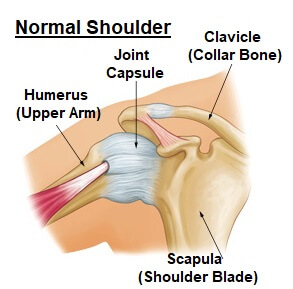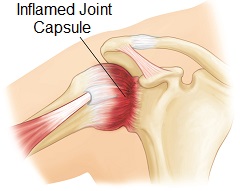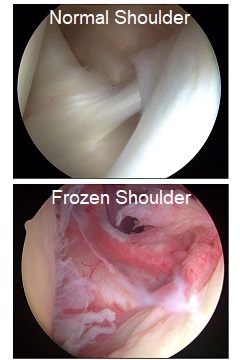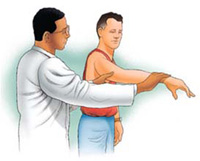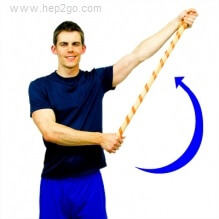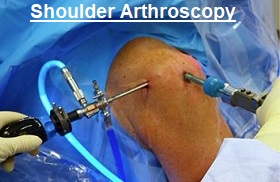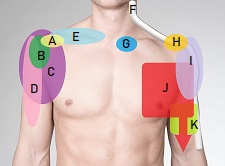- Home
- Common Shoulder Problems
- Frozen Shoulder
Frozen Shoulder Treatment
Written By: Chloe Wilson BSc (Hons) Physiotherapy
Reviewed By: SPE Medical Review Board

Frozen shoulder treatment aims to reduce the pain and limitation caused by tightness in the joint capsule.
Shoulder movement is often greatly restricted with a frozen shoulder, aka adhesive capsulitis, and pain can be constant and severe, particularly at night.
The cause of this tightness is often unclear but may be linked to injury or illness. Normal daily activities such as driving and dressing are often affected and sleep may be very disturbed.
Approximately 3% of the population will suffer from a frozen shoulder at some point, but it is a self-limiting condition, which means it will eventually get better by itself. However, without proper frozen shoulder treatment, it can take up to two years or more to fully recover.
Here we will look at what is going on inside the joint, the causes and symptoms, the best frozen shoulder treatment options, the recovery process and prevention strategies to stop the condition developing in the first place.
What Is A Frozen Shoulder?
A frozen shoulder is where there is inflammation and thickening of the shoulder joint capsule. The shoulder joint is a ball and socket joint. The ball is formed by the top of your humerus (arm bone) and sits in a shallow socket formed by part of the shoulder blade known as the glenoid fossa.
Surrounding the joint is a loose sac known as the joint capsule which is full of fluid that helps to lubricate the joint. The capsule is normally an extremely elastic structure which allows a huge range of movement at the shoulder.
With a frozen shoulder, the joint capsule becomes thickened and stiff, scar tissue forms and as the capsule tightens up, shoulder movement becomes more and more restricted. A frozen shoulder can have a big impact on shoulder range of motion. The medical term for a frozen shoulder is Adhesive Capsulitis.
Frozen Shoulder Causes
There is not always an obvious cause for a frozen shoulder, it often develops completely out of the blue, but there are some predisposing factors:
- Injury: A frozen shoulder may develop after a shoulder injury, even a minor one
- Surgery: Some people develop a frozen shoulder after lung or breast surgery
- Medical Conditions: Frozen shoulders are more common in people who suffer from Diabetes, heart disease, stroke, overactive thyroid, rheumatoid arthritis or lung disease
- Age & Gender: adhesive capsulitis is most common between the ages of 40-70 and is more prevalent in women. Indeed 70% of cases affect women aged 40-60
Stages Of A Frozen Shoulder
A frozen shoulder typically goes through three phases:
Phase 1: Freezing Phase. Pain is the primary symptom here, particularly with any arm movements and at night. The pain gets progressively worse over time and the shoulder gradually stiffens and movement becomes restricted. This phase usually lasts anywhere from 6 weeks to 9 months.
Phase 2: Frozen Phase. Stiffness is the primary symptom here, and shoulder movement may only be half that of the other arm. The pain gradually reduces during this phase but the stiffness persists and may even get worse. This phase may last 4-12 months. Frozen shoulder treatment may be most effective during this phase as the pain settles
Phase 3: Thawing/Recovery Phase. Frozen shoulder symptoms will gradually ease and you should regain full (or almost full) range of motion at your shoulder with little or no pain. This phase can last between 6 and 36 months
Adhesive capsulitis more commonly develops in your non-dominant hand i.e. if you are right handed, you are more likely to develop a frozen shoulder in your left arm and vice versa. It usually only affects one shoulder, but in 20% of cases, people go on to develop adhesive capsulitis in their other arm.
Frozen Shoulder Symptoms
Frozen shoulder symptoms develop gradually, getting progressively worse. The main symptoms of adhesive capsulitis are pain and stiffness.
Twisting movements are usually the first to be affected and the pattern of movement restriction with a frozen shoulder is typically:
Lateral Rotation > Abduction > Medial Rotation > Flexion
This is known as a capsular pattern of restriction. Extension is usually unaffected. During recovery, movement tends to return in the opposite direction with lateral rotation (twisting outwards) being the last to return.
Day to day symptoms of a frozen shoulder include pain and restriction with:
- Shoulder Twisting: e.g. brushing hair, fastening bra, scratching your back or neck
- Reaching Out To The Side: e.g. to reach a seat belt
- Reaching Up: e.g. to get things out of high cupboards or hanging up washing
Diagnosing Adhesive Capsulitis
A frozen shoulder can usually be diagnosed by your doctor or physical therapist. They will look at the range of movement at your shoulder as you move the arm (known as active movement) and then compare it to how much they can move your arm while they support its weight (known as passive movement).
In many cases of shoulder pain, passive movement is considerably greater than active movement as the weight of the arm is supported and the muscles aren’t doing any of the work. However, with a frozen shoulder active and passive will be very similar as the movement is restricted by the tight joint capsule.
#CommissionsEarned from Amazon on qualifying purchases
Frozen Shoulder Treatment
Good frozen shoulder treatment helps to reduce both pain and restriction as well as speed up the recovery process and usually involves a combination of the following
- Medications: pain relief
- Shoulder Injections: corticosteroids
- Heat/Ice: for pain relief
- Physical Therapy: to break down adhesions, reduce pain and increase movement
- Acupuncture: for pain relief
- Surgery: if no improvement after around 6 months
Frozen shoulder treatment will depend on the severity of your condition and what phase you are in.
Phase 1 Treatment: This tends to be the most painful phase so frozen shoulder treatment will focus on controlling the pain. It is important that you keep moving and using the arm to prevent further stiffness developing but without irritating your shoulder
Phase 2 & 3 Treatment: As the pain starts to settle, treatment focuses on regaining range of movement and strength
Let’s look in more detail at the different frozen shoulder treatment options:
1. Painkillers
It is really important to get and keep the pain under control to make the arm more comfortable, allow you to sleep, and to enable you to start other frozen shoulder treatments such as exercise. You may find simple painkillers e.g. paracetamol/Tylenol enough or you may find non-steroidal anti-inflammatories e.g ibuprofen/Advil more effective. Always consult your doctor before taking any medication
2. Shoulder Injections
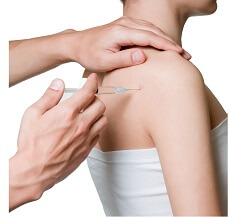
Corticosteroid injections can help to reduce the pain and irritation inside the shoulder joint. Whilst injections won’t cure the problem long-term, they can help to reduce the symptoms for a few weeks or months which can be a welcome relief.
You can find out more about steroid injections, how they work and the possible side effects on our sister site.
3. Heat/Ice
Regularly applying heat pads or ice packs can help to reduce the pain associated with adhesive capsulitis. Some people prefer heat, some prefer ice – see which works best for you. You can find out more about how to use them safely and effectively on our sister site.
4. Physical Therapy
Physical therapy for frozen shoulder will depend on which phase you are in.
Phase 1 Therapy: In phase one it will focus on gentle exercises to maintain your range of movement and to help prevent the restriction from getting worse, without pushing into pain. These frozen shoulder exercises should be done 2-3 daily. It can also really help to use a TENS machine (transcutaneous electric nerve simulator) which sends small electric pulses into your tissues, to help reduce pain.
Phase 2 Therapy: In phase two, physical therapy for frozen shoulder will concentrate on regaining movement. As stiffness is the primary problem here and the pain is starting to diminish you will be encouraged to push your shoulder movements gradually more with a range of frozen shoulder exercises. It is important to keep doing these exercises 2-3 times daily.
Your physical therapist may also perform joint mobilisations and stretches, where they move your shoulder to help regain movement. These may be uncomfortable at the time, but any discomfort should settle within a few minutes.
Phase 3 Therapy: During phase 3 you will continue with your daily exercise programme gradually aiming to regain more and more movement of your shoulder. Your physical therapist will give you exercises to increase both the movement and strength in your shoulder. You should keep going with these until you have made a full recovery. It can be tempting to stop doing exercises when you feel around 80% better, but if you keep going, you should regain that last 20% much faster
To find out more, visit the frozen shoulder exercises section.
5. Acupuncture
Acupuncture is an increasingly popular frozen shoulder treatment as it can really help to reduce the pain associated with adhesive capsulitis. It can also help increase the blood flow to the capsule which can help speed up healing by bring in fresh oxygen and nutrients and carrying away inflammatory chemicals. Acupuncture should ideally be used in conjunction with exercises for maximum benefit and should only be carried out by a licensed professional.
6. Frozen Shoulder Surgery
If your frozen shoulder symptoms are severe and aren’t improving after approximately six months of treatment, your doctor may recommend surgery. The most common options for frozen shoulder surgery are:
Arthroscopic Capsular Release: keyhole surgery with a general anaesthetic (so you are asleep) to cut through tight or scarred tissues to release the capsule
Arthroscopic Hydrodilatation: keyhole surgery under local anaesthetic (so you are awake) where the joint is injected with a mixture of sterile saline, local anaesthetic and steroid. This fills and stretches the joint, breaking down the scar tissue
MUA (Manipulation Under Anaesthetic): where you are put to sleep and an orthopaedic surgeon moves your shoulder in a controlled way to stretch the tight joint capsule
Whatever surgery you have it is vital that it is followed by intensive physiotherapy for frozen shoulder so that you maintain and regain shoulder movement. Find out more about each type of surgery and how to make a great recovery in the frozen shoulder surgery section.
Recovery & Prevention
With or without frozen shoulder treatment, adhesive capsulitis will usually settle of its own accord after around 2 years. But if you want to get there sooner, and minimize symptoms as much as possible, ensure you use the frozen shoulder treatments we have talked about. Most people regain at least 90% of their movement and it is incredibly rare to develop a frozen shoulder more than once in the same side.
Whilst prevention is often difficult due to the cause of adhesive capsulitis being largely unknown, the most important thing is to keep your shoulder moving through as big a range as possible. This can particularly important after an injury or surgery (although always follow the advice of your doctor or physical therapist as in some case they will want to restrict shoulder movements).
Remember always to follow the advice given by your doctor or physical therapist. They will be able to guide you as to how much movement and which exercises are appropriate at each stage of frozen shoulder treatment depending on your own situation.
My Top Tip
It is very easy to get into a vicious cycle with a frozen shoulder. It may hurt slightly to move the shoulder so you start moving it less. Then it starts to stiffen and scar tissue begins to build up causing more pain so you move the shoulder even less. Gradually the movement gets more and more restricted and the cycle continues.
Keeping the shoulder moving as fully as possible is the best way to prevent a frozen shoulder. Don’t be tempted to use a sling to support the arm (unless you have been advised to do so by your doctor) as it may lead to more stiffness.
What Else Can Help?
Frozen shoulder treatment isn't going to be a quick fix, but the earlier you start, the quicker recovery will be. Make sure you check out the following articles:
Remember, a frozen shoulder will always start by being painful and you'll gradually develop a capsular pattern of restriction. If the twisting movements at your shoulder are unaffected, it's unlikely frozen shoulder treatment is what you need, there is probably something else going on - check out our shoulder pain diagnosis section or check out our diagnosis charts.
Related Articles
Shoulder Problems
November 6th, 2024
Diagnosis Charts
February 11th, 2025
Rehab Exercises
December 12, 2023
Page Last Updated: November 12th, 2024
Next Review Due: November 12th, 2026
